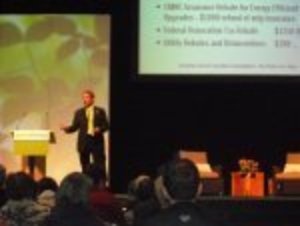First a word about Trees and Awe.
I have always been awestruck by trees. Not at all surprising given their opulent abundance, their firework like displays in spring, their scale, their usefulness and the fact that they live longer than us. The tree I planted when my 7 year old was born could very easily be around when he’s 80. Yet he and I use the word “Awesome” to describe the concrete Skate Park, and other manufactured monuments of our urban landscapes. The beautiful tree lined street pales in my 7 year old’s mind because I haven’t taken the time to tell him what the word awe really means.
This week, at the Grey to Green Infrastructure conference, the economic value of Green Infrastructure, from climate change adaptation and mitigation to energy savings and health impacts will ascribe the economic value of trees and other green infrastructure. The value of green infrastructure is demonstrable and measurable. This is why every year Toronto plants 85,000 trees. The idea of green infrastructure is simply that sometimes the ecological services of living green infrastructure does a better job at managing stormwater,for example, than concrete. As the confluences of climate related issues compounds, Cities around the world are vigorously planting trees, creating green roof bylaws and incorporating green into their stormwater management infrastructure strategies. This is an economic decision, not an environmental one, and every homeowner should understand that their property value could be positively affected.
When my colleagues and I recently studied the comparative market values of treed and un-treed streets in Toronto. What we found surprised us. Not only were values higher in locations with more tree cover but there were also significantly fewer transactions on treed streets. We found that values were 9.5-18.5% higher in treed locations, than those of un-treed streets. We also discovered that there was a graduated lift for streets with some tree cover.
The implication: well, there are two things that are key – first, home owners need to understand that the urban forest can impact their property values is a positive way. The City of Toronto will plant a tree in your front yard for free. Imagine that the city will invest in a upgrade to your property, and to your neighbours, and help you build wealth. Second, the city’s investment in your property pays back in real savings of cost related to stormwater infrastructure, and lower road maintenance costs. Municipal infrastructure investments that have a recoverable payback are rare in cities. Additionally, your front yard tree delivers health benefits in terms of air quality, can deliver real energy savings, produces wood and improves your homes curb appeal. Call 311 visit Toronto.ca or visit www.yourleaf.org to find the tree that is right for your home.
Torontonians value a well spent municipal investment coupled with a direct complement to individual property values. Tree-lined streets appear to deliver amazing results. More rigorous research is required in order to provide a comprehensive study that satisfies the needs of lenders and appraisers to identify value. Such a study would strengthen understanding about the role of urban forests in building personal wealth. Going further, wouldn’t it be great if we could search for property based on tree-lined streets at MLS.ca. I know you are thinking -I can’t search for a house with a solar panel or with a walk score better than X – but we can certainly imagine a better way to buy houses.
Here’s What We Did in our Study:
Lacking the time and resources for a full hedonic pricing model evaluation we sought a simple validation solution. We isolated similar housing stock (age, size, style) on adjacent residential streets with extensive tree canopy on one and a lack of tree canopy on the other. We isolated 4 neighbourhoods in the downtown core. Suburban neighbourhoods will need to be studied based on the age of relative canopy coverage to establish marketplace relevant comparables and stats. Extensive study of this phenomenon is recommended.
We compared assessed values of these houses as a starting point and identified a 9.5 – 18.4% uplift in canopied streets.
Some Studies Referenced in our thinking on this:


